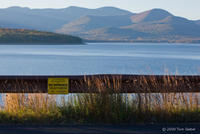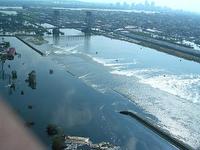-
CO2 emissions as a result of economic growth, decline not symmetrical
Estimating the trajectory of CO2 emissions, an important part of planning for climate change mitigation and adaptation, depends in part on understanding how these emissions are influenced by the economy; new study finds that in years when GDP per capita shrinks, CO2 emissions per capita do not decline in equal proportion to the amount by which they increase with economic growth
-
-
Camera for long-range gas leak detection

New infrared gas imaging camera equipped with a 75 mm lens; it iscertified for use in Class I Div 2 hazardous locations, enabling remote detection and visualization of gas leaks from a great distance
-
-
April 2012 Indian Ocean earthquake indicate s that a new tectonic plate is being born
The 11 April 2012 8.7 magnitude earthquake in the Indian Ocean, unlike its 2004 predecessor, did very little damage; it began at one fault, and when it reached an intersecting fault, it ruptured; in total, four different faults were ruptured over the course of 150 seconds; when earthquakes spread to connecting faults, the rupture rips along faults that branch away from the initial fault like branches of a river; the April 2012 earthquakes took a very different course, running along grid-like patterns and making 90 degree turns; the weird rupture pattern reflects the fact that the region is giving birth to a new tectonic plate
-
-
City of Ottawa sits atop soft soil, a geologic features which amplifies seismic waves

Roughly 20 percent of the Ottawa area is built on bedrock, while the remaining area contains unconsolidated surface deposits; this is not good news for city planners – and dwellers – because soft soil amplifies seismic waves, resulting in stronger ground motion than for sites built over bedrock
-
-
Innovative, “complete” solution for oil-spill cleanup
Corncobs, straw, and other absorbents used to clean up oil spills can hold only about five times their own weight and pick up water, as well as oil; scientists describe what may be a “complete solution” to cleaning up oil spills — a superabsorbent material that sops up forty times its own weight in oil and then can be shipped to an oil refinery and processed to recover the oil
-
-
The Western hemisphere’s largest seawater desalination plant to be built in California

The San Diego County Water Authority announced plans to build the Western hemisphere’s largest seawater desalination plant; the plant will produce fifty million gallons of fresh water per day, enough to supply about 7 percent of the San Diego region in 2020
-
-
New study tracks long-term sea-level rise
Greenhouse gas emissions up to now have triggered an irreversible warming of the Earth which will cause sea-levels to rise for thousands of years to come, new research has shown; mankind has already committed itself to a sea-level rise of 1.1 meters by the year 3000 as a result of greenhouse gas emissions up to now; this irreversible damage could be worse, depending on the route we take to mitigating emissions
-
-
Explosives dumped into Gulf of Mexico pose big problems
Millions of pounds of unexploded bombs and other military ordnance that were dumped decades ago in the Gulf of Mexico, as well as off the coasts of both the Atlantic and Pacific oceans, could now pose serious threats to shipping lanes and the 4,000 oil and gas rigs in the Gulf, warns two oceanographers
-
-
Helping improve microbes’ ability to remediate toxic metal contamination
Naturally occurring bacteria in the Gulf of Mexico did a great job helping to clean up 2010’s huge Deepwater Horizon oil spill, but bacteria can do even heavier lifting; routinely used to help clean up toxic metals at contaminated sites, bacteria and other soil microbes are fed to boost their ability to turn soluble metals into solids that will not leech into streams or aquifers
-
-
More ways to combat water shortages
Water is the one element that every breathing, living organism on Earth needs, and unlike oil, there are no viable alternatives; in many undeveloped countries, water is becoming scarce. Concerns are growing about the availability of water in developed countries as well
-
-
Chile relies on new technologies to cope with frequent earthquakes
Citizens of Chile are used to the ground shaking beneath their feet; in the past two years alone Chile has experienced more than forty earthquakes with magnitudes of six or higher; with so many earthquakes and the potential of thousands dying yearly, Chilean authorities are using new methods to protect their citizens from death and buildings from damage
-
-
Hurricane Irene polluted Catskills watershed

The water quality of lakes and coastal systems will be altered if hurricanes intensify in a warming world, according to a Yale study; researchers found that last summer during Hurricane Irene — the worst storm in the New York area in 200 years — record amounts of dissolved organic matter darkened Catskill waters and affected the Ashokan Reservoir that supplies New York City with drinking water
-
-
Large 11 April 2012 earthquake triggered temblors worldwide for a week
This year’s largest earthquake, a magnitude 8.6 temblor on 11 April centered in the East Indian Ocean off Sumatra, did little damage, but it triggered quakes around the world for at least a week; the findings are a warning to those living in seismically active regions worldwide that the risk from a large earthquake could persist — even on the opposite side of the globe — for more than a few hours
-
-
Debate over causes of levee failure during Katrina intensifies

A court case in which residents of two sections of New Orleans are suing a construction group has put millions of dollars at stake; residents of the Lower 9th Ward and St. Bernard Parish residents claim that Washington Group International (WGI), an Amy Corps of Engineers contractor, removed several buildings and pilings from land along the Industrial Canal as part of a construction plan to expand the canal’s shipping lock, then failed adequately to plug the holes left behind; the holes allowed rainwater from Hurricane Katrina to seep underneath the 14-foot wall, essentially lifting the wall and allowing the areas to be flooded
-
-
Keystone XL pipeline: reliability of remote oil-spill sensors questioned
The oil industry plans to build thousands of miles of pipelines in the next five years, making leak detection a growing issue; many of the new pipelines will cross aquifers and rivers which are used for drinking water and irrigation; the Keystone XL pipeline has already experienced its share of controversies, and now there is a debate over the quality and reliability of the pipeline’s sensor system for remote detection of oil spills
-
More headlines
The long view
How Climate Change Will Affect Conflict and U.S. Military Operations
“People talk about climate change as a threat multiplier,” said Karen Sudkamp, an associate director of the Infrastructure, Immigration, and Security Operations Program within the RAND Homeland Security Research Division. “But at what point do we need to start talking about the threat multiplier actually becoming a significant threat all its own?”
